India’s Andaman Islands: Remote, Rare and Rustic
By Alison Gardner
Senior Travel Editor
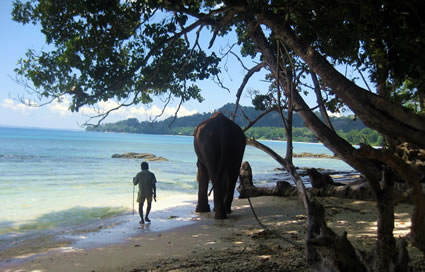
|
On Havelock Island there are still a few working elephants from hardwood logging days, including Rajan, 61 years old, who enjoys a daily stroll along the shore with his mahout.
Photo courtesy of Alison Gardner.
|
After living in the overwhelming human press of Kolkata (Calcutta), India for close to a year where this one city is home to the equivalent of half of Canada’s entire population, my husband, Peter and I chose our rare six-day break getaway carefully. While still wanting to explore another piece of India, we considered a destination not too far in a country where travel predictably consumes a lot of time, not too dense with people and perpetual noise, and not too popular with Indian and international vacationers. After all, India does boast the largest middle class of any country in the world (350 million), and they do love to travel!
A direct flight of 1,000 kilometers (600 miles) and only two hours from Kolkata southeast across the Bay of Bengal to the Andaman Islands capital, Port Blair, was enticing in itself. However, learning that the entire population of the islands was under 350,000 (a mere village in Indian terms!), we decided to buy a ticket to the unknown.
Well, apparently not quite unknown … even 50,000 years ago. With DNA testing, we have now confirmed that humans migrating out of Africa across the Middle East and Asia used the Andaman and Nicobar Islands as stepping-stones to Indonesia and Australia. We know this because the last remnants of their ancestors still live on several no-go islands in distinctive Stone Age tribal groups, vigorously protected by the Indian government from intrusion or influence at each tribe’s request. Theirs is a fascinating story of virtual isolation, even from each other, despite a mention in the tales of Marco Polo and visits from occasional trading ships, until the British colonized these islands as a naval base and penal colony in the mid-19th century. Almost all the resident population today migrated from mainland India after independence in 1947.
Being more keen on archaeology and history than on sun and sand, we lingered several days around Port Blair whose highlights included an extensive anthropological museum that sweeps visitors through 50,000 years of human presence in the islands. We also took a 10-minute ferry ride across the harbor to Ross Island, a living museum of British colonial rule, allowing us to step into the once-orderly center of British life and administration there until 1947.
Ross Island alone is worth a half-day’s exploration with walking paths framed by tall graceful forests and plenty of outlooks to sit and contemplate the arrogance and frailties of mighty empires. It is frankly unnerving yet remarkably moving to see sturdy brick and stone colonial buildings strangled under the press of tree roots, military barracks, once-gracious family homes, and imposing churches, now devoid of stain glass windows. In a mere 66 years, all has been dramatically reclaimed by Nature as can only happen in a tropical environment.
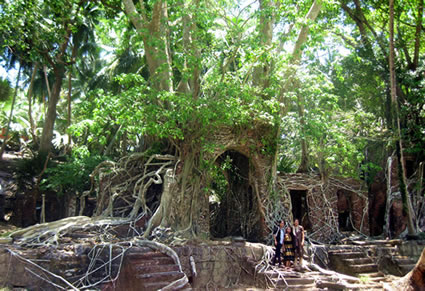
|
On Ross Island, a 10-minute ferry ride across Port Blair’s harbor, nature has dramatically reclaimed every building of the former British administration in just 66 years.
Photo courtesy of Alison Gardner.
|
As the darkest witness to British occupation, it is also important to learn about the monstrous, seven-wing Cellular Jail in Port Blair, a remarkable piece of circular architecture completed in 1906. It was purpose-built to confine Indian independence fighters who were already unsettling colonial rule across the country decades before independence. Today, as an educational museum with a sound and light show, this 693-cell honeycomb of tiny solitary confinement spaces is an impressive testimony to the life, suffering and death of its prisoners, mainly well-educated Indian intellectuals. The odds of escaping back to the mainland were as likely as escaping from the Moon.
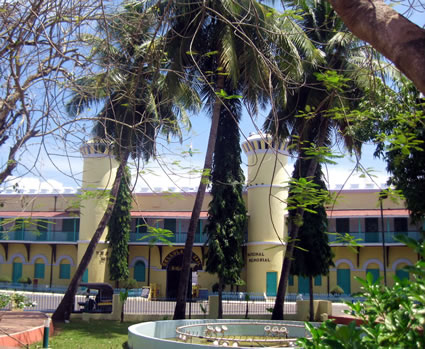
|
Last used as a British prison in 1938 and revived by the Japanese during their wartime occupation of these islands, Cellular Jail became an historical monument in 1979.
Photo courtesy of Alison Gardner.
|
Havelock Island’s Food, Water Fun and Tsunami Alerts
Most Andaman vacationers head for Havelock Island (pop. 6,000) on the first ferry available. It is a world-class diving and snorkeling paradise, the ultimate playground for swimming and surfing off white sand beaches, and ideal for guided kayak exploration in protected coves and along the edges of mangrove forests with one eye on the lookout for rarely seen saltwater crocodiles. Roads are mainly one lane and paved with potholes, while three-wheeled tuk-tuk taxis are predictably elusive except at the ferry dock.
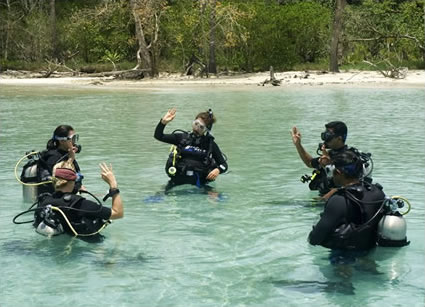
|
In Havelock Island’s scuba-heaven environment, Andaman Bubbles runs a highly professional operation, offering shoreline classes for novices and dive boat excursions with world-class coral reef experiences.
Photo courtesy of Andaman Bubbles.
|
After the first day waiting over an hour by the roadside for a tuk-tuk driver who swore on his cell phone that he would “be there in five minutes,” I decided to abandon my lifetime self-imposed ban on riding a motorbike or scooter. With an attitude of fatalism on my part, we rented a spine-jarring, shock absorber-less scooter for US$8 a day to randomly explore the island on our own timetable.
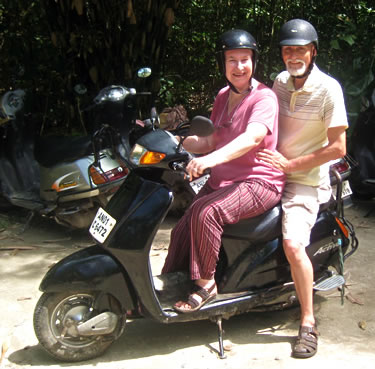
|
On Havelock Island, Transitions Abroad’s Senior Travel Editor and her husband rented their first-ever scooter to explore the highlights.
Photo courtesy of Danielle McIlven.
|
On our second Havelock day, the scooter proved its worth when, within an hour, the region experienced two earthquakes of 8.5 and 8.2 on the Richter scale just south of the Andamans in Sumatra, Indonesia. We were lingering over an outdoor lunch at the beachfront of our rustic “villa” when tables and chairs began dancing around. Instantly recalling snapshots of the devastating 2004 tsunami that followed similar quakes in the Indonesian archipelago, we asked our Indian host about his plan for guest evacuation. He had none. However, he did report that he had dispatched the cook to plant a stick at the shoreline where the sea met the exposed sand while the tide receded at its normal snail’s pace.
He recommended that for the next hour we and other hovering guests should watch the stick. He comfortingly added that if the sea quickly sucked back, leaving only sand in the shipping channel between us and the mangrove islands on the far side, we must inform him immediately. “So,” I clarified, “if we witness this phenomenon, how long do we have until a tsunami wave hits our beach?” “About 10 minutes,” he replied thoughtfully.
On our battered TV we learned from the BBC reporting this fast-breaking news far away in London that 28 countries in our region, including India, had issued the highest level of tsunami alert. Apparently, coastal inhabitants within a thousand kilometers radius were running for the hills, though the reporter was obviously not on Havelock Island where only one up-market resort bothered to shepherd its guests to a nearby hill. Unperturbed, we had the key to our scooter in hand and daypacks stuffed with passports, valuables and granola bars, ready to scoot for higher ground a good 20 minutes away.
No, 2004 did not repeat itself ... even slightly ... so we dared fate by taking to the water for a day of diving, snorkeling and kayaking. Andaman Bubbles Dive Centre runs a top-notch operation that serves beginners to veteran divers with different programs that introduce guests to the colorful reef and sea life. With another company, Barefoot Scuba, a guided sea kayak exploration also encouraged us to do some pleasant coastal exploration.
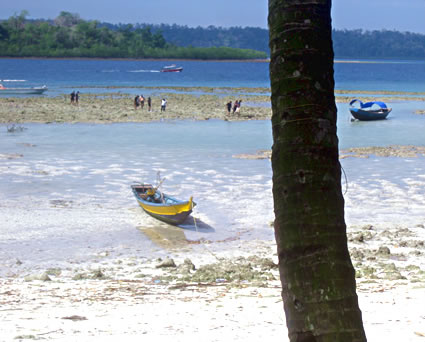
|
The tide is going out quite naturally on our resort beach, thankfully with no sign of an imminent tsunami.
Photo courtesy of Alison Gardner.
|
Refreshed and ready for another assault by Kolkata, we regretfully surrendered our scooter, and expertly flagged down a tuk-tuk heading for the ferry dock. We were now insiders of two of the planet’s unfamiliar treasure islands.
|
For More Information
Getting There: This slim north/south necklace of mostly uninhabited tropical islands parallels the coast of Myanmar (Burma) along the eastern shore of the Bay of Bengal. A two-hour flight from Kolkata or from Chennai (Madras) further down India’s east coast are the most common entry for international travelers to the administrative capital, Port Blair (pop. 100,000) on South Andaman Island. There are also flights from Delhi. Alternatively, the hardiest adventurers with a flexible travel timetable may prefer a two- night rustic ferry ride from the Indian mainland.
Restrictions: Indian administrators are particularly vigilant about monitoring visitors and their natural propensity to wander widely, partly because these islands together with the Nicobar Islands (no visitors allowed!) to the south are strategically important to the Indian military; partly to protect the privacy of six distinct tribal groups close to extinction, and partly to protect three eco-systems – tropical forests, mangroves and coral reefs – that support a staggering variety of rare and endangered plants and animals. Only a handful of islands are open to day visitors or offer overnight accommodation, and arriving international visitors must obtain a permit at the Port Blair airport. This is a serious Customs zone, similar to entering a country.
Ferries from Port Blair to Havelock Island: Visitors have the choice of a 1.5-hour ferry ride by the privately owned 280-passenger Makruzz catamaran with assigned seating or 2.5 hours aboard the cheaper, rustier, often unreliable government ferry. I travelled one way on each of them, on time and uneventfully. Port Blair’s incoming and outgoing flights to the mainland do not dovetail with ferry schedules either to or from Havelock, so an overnight stay in the capital each way is necessary.
Accommodations: South Andaman and Havelock Island beds are limited but varied from hostels and huts to a few four-star resorts. In the favored months from October through March, book well ahead.
Port Blair:
Fortune Resort Bay Island is a comfortable four-star option, perched on a cliff overlooking the Bay of Bengal, with a constantly changing tableau of freighters, ferries and yachts passing by below. The Indian cuisine buffet is plentiful, rooms have the most imaginative stock of room amenities ever encountered, and the staff is knowledgeable about South Andaman, its services and activities to the last detail.
Havelock Island:
The two best accommodations are dedicated eco-friendly Barefoot at Havelock and Wild Orchid, each blessed with creative menus and classic tropical beachfronts to compete with any in the world. Even if you are not staying there, do go for a meal. Meals on Havelock are a varied pleasure with plenty of fresh seafood and prices from budget to multi-course fine dining.
|
|
